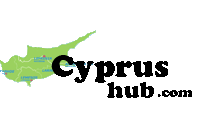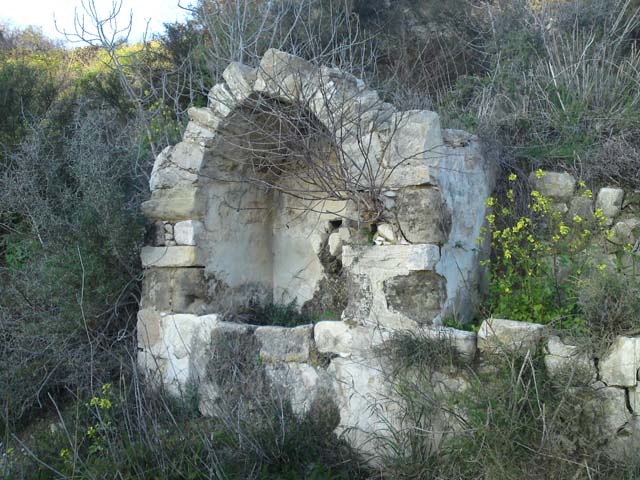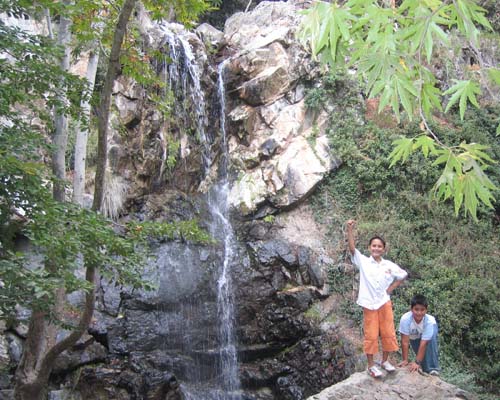Sites and Monuments-Lemesos
Amathous Archaeological Site
One of the most important city - kingdoms of ancient Cyprus. According to mythology it was founded by King Kinyras and was also where Theseus left the pregnant Ariadne to be cared for after his battle with the Minotaur The city of Amathous developed on two levels – the lower and the upper city (Acropolis). Excavations have brought to light the Agora complex with the stoae (covered walks), baths and other adjacent buildings, four basilicas, the sanctuary of Aphrodite, an aqueduct and the harbour, which nowadays lies under the sea level. Outside the walls lie the east and west necropolis.
| Address: | Amathous, Lemesos |
| Operating Hours: | Daily: 08:00 - 17:00 (November - March), 08:00 - 18:00 (April - May, September - October), 08:00 - 19:30 (June - August) |
| Operating Period: | All year round |
| Entrance Fee: | 1,71 Euro |
Agora of Amathous
In Amathous, the agora was a large rectangular stone - paved area, flanked by porticoes on three sides and a monumental square fountain in the centre. The small rooms at the back of the west portico were used as shops. Along the open, fourth side on the south ran the main road of the lower city. On the other side were the Hellenistic baths. Roman baths were found on the east of the east portico.
| Address: | Amathous, Lemesos |
| Operating Hours: | Daily: 09:00 - 17:00 (November - March), 09:00 - 18:00 (April - May, September - October), 09:00 - 19:30 (June - August) |
| Operating Period: | All year round |
| Entrance Fee: | 1,71 Euro |
Kourion Archaeological Site
One of the most spectacular archaeological sites on the island, Kourion was an important city kingdom where excavations continue to reveal impressive new treasures. Noted particularly for its magnificent Greco - Roman Theatre, Kourion is also proud home to stately villas with exquisite mosaic floors and an early Christian Basilica among other treasures. Originally built in the 2nd century B.C., Kourion’s awe - inspiring theatre is now fully restored and used for musical and theatrical performances. The House of Eustolios, consisting of a complex of baths and a number of rooms with superb 5th century A.D. mosaic floors, was once a private Roman villa before it became a public recreation centre during the Early Christian period. The Early Christian Basilica dates to the 5th century and was probably the Cathedral of Kourion, with a baptistery attached to the north face. The House of Achilles and the House of the Gladiators also have beautiful mosaic floors. The Nymphaeum, dedicated to the water nymphs, is an elegant Roman structure. The 2nd century A.D. stadium is located outside the main Kourion site, about 1kilometre to the west on the right hand side of the road to Pafos. Also impressive is the Sanctuary of Apollo Hylates, situated about 2,5 kilometres west of the ancient city.
| Address: | Kourion, Lemesos |
| Operating Hours: | Daily: 08:00 - 17:00 (November - March), 08:00 - 18:00 (April - May, September - October), 08:00 - 19:30 (June - August) |
| Operating Period: | All year round |
| Entrance Fee: | 1,71 Euro |
Theatre of Kourion
Kourion Theatre is located on the southern end of the abrupt hill on which the city is built. It was constructed at the end of the 2nd century B.C., but took its current dimensions during the 2nd century A.D. The theatre consists of a semi - circular orchestra that is surrounded by seats of the cavea (subterranean cells). It was enclosed to the south by the building of the scena frons (façade) that must have reached the height of the cavea, though today only the foundations remain. On either side of the scene were two vaulted parodoi (corridors) from where the audience entered the theatre. Kourion Theatre could seat up to 3.500 spectators. During later reconstruction, it was modified so as to accommodate animal hunts. Many cultural activities and theatrical performances take place at Kourion Theatre, especially during the summer.
| Address: | Kourion, Lemesos |
| Operating Hours: | Daily: 08:00 - 17:00 (November - March), 08:00 - 18:00 (April - May, September - October), 08:00 - 19:30 (June - August) |
| Operating Period: | All year round |
| Entrance Fee: | 1,71 Euro |
Sanctuary of Aphrodite, Amathous
The Sanctuary of Aphrodite at at the Acropolis of Amathous is believed to be second only to that of Palaepafos, of which, according to the myth, it was an off shoot establishment. The Greek-style temple and the remains immediately below it, go back to the late Ptolemaic and Imperial times. Evidence of the presence of a sanctuary in the area before then includes votive offerings going back to the mid 8th century BC. According to tradition, there were two other temples at the Acropolis of Amathous apart from the temple of Aphrodite – one dedicated to Adonis and the other to Hercules. Their remains, however, have not yet been located.
| Address: | Amathous, Lemesos |
| Operating Period: | All year round |
The Sanctuary and Temple of Apollo Hylates at Kourion
Situated about 2,5 kilometres west of the ancient city of Kourion, the Sanctuary of Apollo Hylates was one of the principal religious centres of Cyprus where Apollo was worshipped as Hylates, god of the woodlands. There were three fairly distinct building periods. The Archaic Sanctuary developed essentially in the 7th century B.C. while the Ptolemaic Sanctuary belongs to the 3rd century BC. Finally, the Roman Sanctuary dates to the 1st century A.D.
| Address: | Kourion, Lemesos |
| Operating Hours: | Daily: 08:00 - 17:00 (November - March), 08:00 - 18:00 (April - May, September - October), 08:00 - 19:30 (June - August) |
| Operating Period: | All year round |
| Entrance Fee: | 1,71 Euro |
Central Municipal Market
The Municipal Market of Lemesos (Limassol), a large, stone - built structure, consisting of big halls and shops occupying an area of 3000 square metres , is situated in the old town. It was built in 1917 but took its present form in 1947. Until the 1970s, the market and the surrounding shops constituted the centre of trade and other commercial and social activities of the town. But it began to decline after that date because of the rapid expansion of the city. It is now a listed building and part of the Lemesos (Limassol) Municipality project to upgrade the market’s role and importance.
| Address: | Lemesos |
| Operating Hours: | Monday - Saturday: 06:00 - 15:00 |
| Operating Period: | All year round |
Kolossi Medieval Castle
Kolossi Castle is situated in the village of Kolossi, 11 kilometres west of Lemesos (Limassol). It was built in the 15th century on the ruins of a former fortress dated to the beginning of the 13th century. The castle itself is a 21 metres high square tower with three floors. The ground floor is divided into three parts and was probably used as storeroom. In the middle of the east side is a stone stairway leading first to the second floor, where the kitchen was probably located, and then to the third floor. The third floor was divided into two big halls and was the ‘house’ of the Commander. To the south of the castle there is a courtyard enclosed by walls and the ruins of an auxiliary building, probably a stable or a storehouse. On the southwest corner of that building there was an entrance, protected by a circular tower. Sugarcane refinery installations have been located to the east of the castle.
| Address: | Kolossi, Lemesos |
| Operating Hours: | Daily: 08:00 - 17:00 (November - March), 08:00 - 18:00 (April - May, September - October), 08:00 - 19:30 (June - August) |
| Operating Period: | All year round |
| Entrance Fee: | 1,71 Euro |
Kourion Mosaics
Kourion is noted for the well - preserved mosaics that decorate the floors of its stately villas. One of these is the 3rd century A.D. House of Gladiators that takes its name from a series of mosaics near its main courtyard representing gladiatorial combats. The central part of the house was an atrium. Entrance was through a stairway on the northeast corner. This opened onto another, smaller atrium joined to the central one by a corridor. The southern part of the building was destroyed, probably due to earthquakes in the 4th century A.D. To the east of the corridor is a typical bath complex. Located east of the theater, the House of Eustolios probably dates to the early 5th century A.D. and takes its name from an inscription citing Eustolios as the builder. A mosaic with a welcoming inscription graces the antechamber of the entrance. There are mosaic decorations in three of the porticoes and a bath complex to the north. The house is believed to have been originally built as a home and was probably opened to the public after the construction of the baths and the addition of the mosaic floors. Consisting of an open courtyard with rooms on two sides and a portico, the 4th century A.D. House of Achilles takes its name from the mosaic of the legendary Greek hero. Probably used to receive official guests, the house has other mosaic floors.
| Address: | Kourion, Lemesos |
| Operating Hours: | Daily: 08:00 - 17:00 (November - March), 08:00 - 18:00 (April - May, September - October), 08:00 - 19:30 (June - August) |
| Operating Period: | All year round |
Lemesos Medieval Castle
Lemesos (Limassol) Fort is situated in the heart of the old town, just above the old harbour. According to tradition, this is where Richard the Lionheart married Berengaria of Navarre and crowned her Queen of England in 1191. The fortified walls are of considerable archaeological interest and thought to be fragments of a much larger castle. The exact date of the fort’s construction is not known. According to Etienne de Lusignan, it was built in 1193 by the founder of the Lusignan dynasty, Guy de Lusignan but the first official reference to the fort dates to 1228, during the involvement of Frederic II of Germany in the affairs of Cyprus.Today, the fort houses the Medieval Museum of Cyprus.
| Address: | Richard & Berengaria, Lemesos |
| Operating Hours: | Tuesday - Saturday: 09:00 - 17:00, Sunday: 10:00 - 13:00 Monday: closed |
| Operating Period: | All year round |
| Entrance Fee: | 3,42 Euro |


